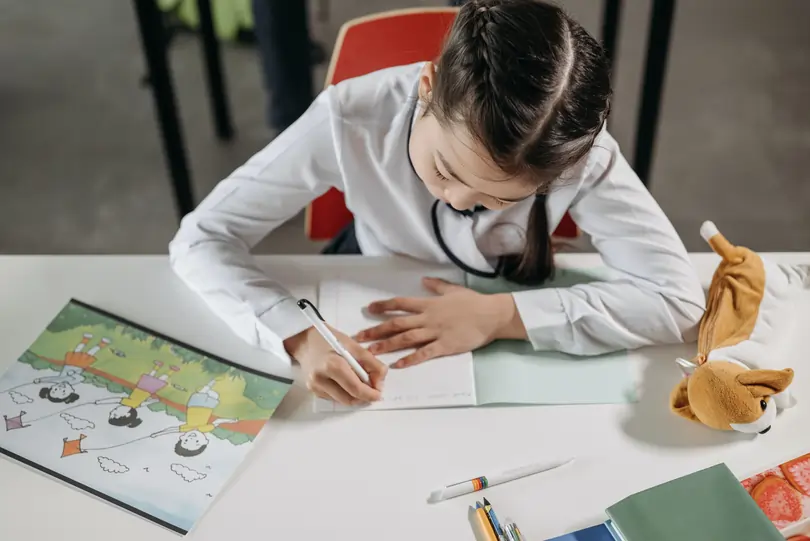What are Articles?

What are Articles
Articles are a type of determiner used to identify whether a noun is specific or unspecific. There are a total of three articles: a, an, and the.
The is the only definite article, used when referring to a specific and previously mentioned or easily identifiable item, like ‘the cat in the garden’. A and an are indefinite articles, often used when discussing any one of a group, without specifying which one, such as ‘a dog’ or ‘an apple’.
Eg. The cat that I adopted last month is incredibly playful.
In this sentence, the is a definite article. It’s used before the noun ‘cat’ to specify a particular cat, not just any cat. It indicates that the speaker is referring to a specific cat, the one that was adopted last month. The definite article the is used to single out and refer to a specific, known, or previously mentioned thing or person, making it clear which one is being discussed.
Eg. I saw a beautiful flower in the garden.
In this sentence, a is an indefinite article. It’s used before the noun ‘flower’ to refer to any flower in a general or non-specific sense. It doesn't specify a particular flower but rather introduces the concept of a single, non-specific flower. In this case, a is used to indicate that the speaker saw a flower, but it could be any flower in the garden, not a specific one.
Three types of articles
The definite article: The
The primary definite article in English is the. When used with singular nouns, the refers to a specific, known, or previously mentioned item, making it clear which one is being discussed. The definite article can be used with singular, plural, or uncountable nouns.
Eg. The book on the shelf is mine.
In this example, the specifies a particular book on the shelf.
Eg. The flowers in the garden are beautiful,
With plural nouns, the is used to indicate a specific group of items or objects. In this example, the specifies that the speaker is referring to the particular flowers in that specific garden.
Eg. The water in the glass is cold
With uncountable nouns, the is used to denote a specific quantity of an uncountable substance or idea.
The indefinite article: a and an
The indefinite article has two forms: a and an. They’re used before singular and countable nouns when one is not referring to a specific or previously mentioned item but wants to introduce or mention something in a more general way.
Eg. After a long, tiring day at the conference, I decided to unwind by taking a leisurely walk along a serene, moonlit beach.
In this example, a is used before ‘long’ to indicate any extended period of time, a before ‘leisurely’ refers to any relaxing walk, and a before ‘serene’ emphasises any peaceful beach without specifying a particular one.
Eg. In the attic of an old, creaky house, they stumbled upon an assortment of dusty, forgotten family heirlooms, each with its own unique story.
Here, an is used before ‘old’ to indicate any aged house, and an before ‘assortment’ refers to any collection of family heirlooms.
Using Indefinite Articles with Uncountable Nouns
Using indefinite articles with uncountable nouns can be a bit tricky because uncountable nouns represent substances, concepts, or ideas that cannot be counted individually.
Unlike countable nouns, which can take a or an to specify one of many, uncountable nouns do not use these indefinite articles to indicate quantity. Instead, uncountable nouns are typically used with some, a lot of, a bit of, much, or a little to convey an unspecified amount or degree.
Eg. I want to have a little ice cream after dinner.
In this example, ice cream is a yummy treat and an uncountable noun because we don’t count it like apples or cookies.
Eg. She has a lot of love for animals.
In this example, love is a feeling which can’t be counted, like gifts or friends.
Using Articles with Pronouns
Because articles and possessive pronouns both indicate specificity, you should only use one or the other. Using them together may confuse your readers. Below are some examples.
Eg. Why are you eating the my cookie?
Both the and my should not be used together as both identify the same noun (cookie). Instead, you should pick one or the other based on the intended meaning.
Eg. Why are you eating the cookie?
Eg. Why are you eating my cookie?
When to omit Articles
There are times when articles should be omitted before certain nouns. In situations like these, the article is implied instead of explicitly stated. Generally speaking, articles are omitted when it’s not necessary to indicate the definiteness or indefiniteness of a noun. Below are some examples.
Non-countable nouns used in a general sense
Eg. She enjoys a music. (Incorrect)
Eg. She enjoys music. (Correct)
Plural countable nouns used in a general sense
Eg. Dogs are the popular pets. (Incorrect)
Eg. Dogs are popular pets. (Correct)
General truths and abstract concepts
Eg. The honesty is an important trait to have. (Incorrect)
Eg. Honesty is an important trait to have. (Correct)
FAQs about Articles
What are articles in English grammar?
Articles are small words like 'the', 'a', and 'an' used before nouns to specify their definiteness or indefiniteness.
How do I choose between 'a' and 'an'?
'A' is used before words that start with a consonant sound, while 'an' is used before words that begin with a vowel sound. For example, 'a cat' and 'an apple'.
When should I use 'the' as opposed to 'a' or 'an'?
"The" is the definite article used for specific or previously mentioned nouns, while "a" and "an" are indefinite articles used for general or unspecified nouns.
Can articles be omitted in sentences?
Yes, articles can be omitted in certain cases, such as when discussing general truths, plural countable nouns in a general sense, names, titles, and non-countable nouns in a general sense.
What is the purpose of articles in English grammar?
Articles help provide clarity, specificity, and context to nouns in sentences. They indicate whether we are talking about something known or unknown, which is crucial for effective communication in English.


 SG
SG  VN
VN 















